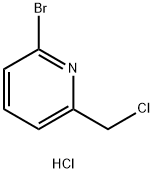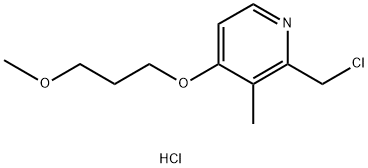2-(Chloromethyl)pyridine hydrochloride
Synonym(s):2-Picolyl chloride hydrochloride
- CAS NO.:6959-47-3
- Empirical Formula: C6H7Cl2N
- Molecular Weight: 164.03
- MDL number: MFCD00012811
- EINECS: 230-149-9
- SAFETY DATA SHEET (SDS)
- Update Date: 2025-07-04 15:12:38

What is 2-(Chloromethyl)pyridine hydrochloride?
Chemical properties
White to pale brown solid
The Uses of 2-(Chloromethyl)pyridine hydrochloride
2-(Chloromethyl)pyridine hydrochloride was used as reagent in base catalyzed alkylation of p-tert-butylcalix[6]arene and p-tert-butylcalix[5]arene in DMF. It was used in the synthesis of Gd3+ diethylenetriaminepentaacetic acid bisamide complex, a Zn2+-sensitive magnetic resonance imaging contrast agent.
Definition
ChEBI: A hydrochloride obtained by combining 2-(chloromethyl)pyridine with one molar equivalent of hydrochloric acid.
General Description
Off-white chunky solid.
Air & Water Reactions
Soluble in water.
Reactivity Profile
2-(Chloromethyl)pyridine hydrochloride is incompatible with strong oxidizing agents.
Fire Hazard
Flash point data for 2-(Chloromethyl)pyridine hydrochloride are not available. 2-(Chloromethyl)pyridine hydrochloride is probably combustible.
Properties of 2-(Chloromethyl)pyridine hydrochloride
| Melting point: | 120-124 °C(lit.) |
| Boiling point: | 128-129 |
| Density | 0,944g/cm |
| refractive index | 1,499-1,501 |
| storage temp. | Inert atmosphere,2-8°C |
| form | Crystalline Mass |
| color | Yellow-green to light brown |
| Water Solubility | >=10 g/100 mL at 22 ºC |
| Sensitive | Hygroscopic |
| BRN | 3689155 |
| CAS DataBase Reference | 6959-47-3(CAS DataBase Reference) |
| EPA Substance Registry System | 2-(Chloromethyl)pyridine hydrochloride (6959-47-3) |
Safety information for 2-(Chloromethyl)pyridine hydrochloride
| Signal word | Danger |
| Pictogram(s) |
 Corrosion Corrosives GHS05  Exclamation Mark Irritant GHS07 |
| GHS Hazard Statements |
H302:Acute toxicity,oral H314:Skin corrosion/irritation |
| Precautionary Statement Codes |
P260:Do not breathe dust/fume/gas/mist/vapours/spray. P270:Do not eat, drink or smoke when using this product. P280:Wear protective gloves/protective clothing/eye protection/face protection. P301+P312:IF SWALLOWED: call a POISON CENTER or doctor/physician IF you feel unwell. P303+P361+P353:IF ON SKIN (or hair): Remove/Take off Immediately all contaminated clothing. Rinse SKIN with water/shower. P305+P351+P338:IF IN EYES: Rinse cautiously with water for several minutes. Remove contact lenses, if present and easy to do. Continuerinsing. |
Computed Descriptors for 2-(Chloromethyl)pyridine hydrochloride
| InChIKey | JPMRGPPMXHGKRO-UHFFFAOYSA-N |
2-(Chloromethyl)pyridine hydrochloride manufacturer
JSK Chemicals
3Y
Phone:+91-9879767984
Whatsapp: +91-9879767970
product: 2-(Chloromethyl)pyridine 6959-47-3 99%
New Products
Indole Methyl Resin tert-butyl 9-methoxy-3-azaspiro[5.5]undecane-3-carboxylate Boc-His(Boc)-OH 2-CTC Resin 4-Chloro-7-tosy1-7Hpyrrolo[2,3-d]pyrimidine 5,7-Dibromo-1H-indole 2,5-dichloro-N-hydroxy-4,6-dimethylpyridine-3-carboximidamide 2,2-Dimethoxy-7-azaspiro[3.5]nonane hydrochloride 4-chloromethyl-5-methyl-1,3-dioxol-2-one (DMDO-Cl) R-2-BENZYLOXY PROPIONIC ACID 1,1’-CARBONYLDIIMIDAZOLE 1,1’-CARBONYLDI (1,2-4 TRIAZOLE) N-METHYL INDAZOLE-3-CARBOXYLIC ACID 4-((2-hydroxyethyl)thio)benzoic acid 1-(TERT-BUTOXYCARBONYL)-2-PYRROLIDINONE Methyl 6-methylnicotinate 3-Pyridineacrylic acid tert-Butyl carbazate TETRAHYDRO-2H-PYRAN-3-OL 2-((4-morpholinophenylamino) (methylthio) methylene) malononitrile 3-(4-morpholinophenylamino)-5-amino-1H-pyrazole-4-carbonitrile 2,4-dihydroxybenzaldehyde 1,3-Diethyl-1,3-Diphenylurea Methyl 2-methylquinoline-6-carboxylateRelated products of tetrahydrofuran








You may like
-
 6959-47-3 2-Chloromethylpyridine hydrochloride 98%View Details
6959-47-3 2-Chloromethylpyridine hydrochloride 98%View Details
6959-47-3 -
 2-(Chloromethyl)pyridine 6959-47-3 99%View Details
2-(Chloromethyl)pyridine 6959-47-3 99%View Details
6959-47-3 -
 2-(Chloromethyl)pyridine Hydrochloride CAS 6959-47-3View Details
2-(Chloromethyl)pyridine Hydrochloride CAS 6959-47-3View Details
6959-47-3 -
 2-(Chloromethyl)pyridine hydrochloride, 98% CAS 6959-47-3View Details
2-(Chloromethyl)pyridine hydrochloride, 98% CAS 6959-47-3View Details
6959-47-3 -
 2-(Chloromethyl)pyridine hydrochloride CAS 6959-47-3View Details
2-(Chloromethyl)pyridine hydrochloride CAS 6959-47-3View Details
6959-47-3 -
 Pyridine 99.5% HPLC /UV SpectroscopyView Details
Pyridine 99.5% HPLC /UV SpectroscopyView Details
110-86-1 -
 Dibutyl PhthalateView Details
Dibutyl PhthalateView Details
84-74-2 -
 Thiourea 99% ARView Details
Thiourea 99% ARView Details
62-56-6
Statement: All products displayed on this website are only used for non medical purposes such as industrial applications or scientific research, and cannot be used for clinical diagnosis or treatment of humans or animals. They are not medicinal or edible.
